September 29, 2009
Tomorrow's essential Afghan reading, today
Capt. Doug Beattie, MC, has a new book out on his time as a British ANA mentor in Helmand in mid-2008, his 14th operational tour in 27 years with the British army. The Daily Mail excerpts:
Slowly the ANA troops moved towards the compound. They used their grenades to clear it, with devastating results - at least for the six Taliban who were killed. We'd been successful. We'd killed a number of the enemy and recovered some of their equipment. Crucially, the ANA had - eventually - stepped up to the mark and done the job. We'd even taken a prisoner - though, as I looked round at him, I could see he was taking a bit of punishment from one of his captors.
'Oi! Don't be doing that,' I screamed. The soldier meting out the blows gave me a quizzical look and wandered off.
We started to pull out. The ANA soldiers were in front with Stevo, a Royal Irish colleague, and our prisoner. Suddenly a burst of gunfire stopped me in my tracks.
I grabbed my radio: 'Stevo, what the hell is going on?'
'They've shot the prisoner. The Afghans - they've bloody shot him.'
Associated strategery musings
Okay, I'm tired of talking about T.E. Lawrence, but he does constitute a common frame of reference of sorts, so I'm going to do it one more time.
Lawrence, you'll recall, had three great insights worth remembering in the Afghan context. He advised both British and Arabs that the large Turk garrison in Medina, which was exerting no effect on anything, could be safely ignored; that the long rail line to Medina could be savagely interdicted, and that the port of Aqaba, if taken, could secure Arab logistics and their participation in the war. Hence, his early strategy of bypassing Medina, attriting the Turks along the railline, and seizing Aqaba.
Lawrence was, of course, an insurgent, not a counterinsurgent. In the Afghan context, one might ask, where is the insurgents' Medina? Where is their Aqaba? The rail line equivalent, one would argue, is fairly obvious: the long ring road Western and Afghan forces keep free of IEDs and ambushes at great cost every day. But where are they trying to tie us down, and where are they aiming to strike to expand their campaign to a new level of effectiveness?
The maps in the post below, showing the provincial breakdown of coalition fatalities, lend themselves to one interpretation.
That interpretation would be the increasingly compelling theory that the Taliban have little interest in controlling or even fighting in the country's major population centres any time soon, as that would highlight their deficiencies in governance and compromise urban sanctuaries where they can currently organize covertly so long as they remain unarmed and unthreatening (the best place to hide from UAVs being a city).
In this theory, what they really want to dominate militarily are the environs to those urban areas, the area within the sound of artillery fire (15-25km) in any populated direction from the city: close enough so the population feels threatened. Operating in and through these environs areas, through rapid, destructive attacks on security infrastructure, targetted assassinations both in and outside the city, and intimidation-type information ops at night (and the occasional spectacular attack, like the one on Sarpoza prison), they keep the city population cowed and lacking confidence in their own government and the coalition without ever having to physically enter it or intentionally target the populace. This has already succeeded to a great degree in the Kandahar City environs, and the rapid increase in activity this year in Wardak and to a lesser extent Kapisa could be indications they're now trying to replicate that success to the environs of Kabul.
This spiritual, not physical domination of the environs areas is coupled with two other secondary operational methods. The first is the interdiction of the national road infrastructure with IEDs and occasional ambushes, tying down large numbers of security forces in their sweeping and defense, at an extremely low cost to the insurgents, while increasing feelings of urban isolation and government impotence. It also tends to keep Westerners in their armoured vehicles more, and so not interacting with the population.
The second is to use populated but non-urban areas of provinces both inside and outside the environs, specifically those where the government has been unable to establish a strong police presence, as "security sponges" to soak up Western counter-strokes. The lack of indigenous security grants the insurgents freedom of movement for low-profile activities in these areas such as recruitment, fundraising, and creation of defensible enclaves, using IEDs and ambush positions placed to react to incursions and draw casualties, with any direct fire engagements conducted only under highly favourable terms (such as, only when the Westerners have had to dismount due to terrain).
Any well-placed, effective combat outposts in these sponge areas are beseiged as effectively as possible, to keep the forces in them hemmed in. These areas are not necessarily key terrain for the insurgents, however... one rural Pashtun village with high compound walls and narrow lanes being as good as any other for this purpose. The intent is any determined effort to enter these areas by the Coalition will hit only IEDs and air.
The upshot of this is that those somewhat-populated sponge areas within the environs are valuable to the enemy in proportion to how large the urban population they affect; and that sponge areas outside the environs areas (such as much of Helmand province) are not particularly valuable to them at all: they are our "Medina" in this analogy, while the urban environs of the next big city over (such as Kabul) are their "Aqaba", where they're looking to make inroads. And, with these tactics having proven largely successful up to this point, it seems unlikely the Taliban are going to be particularly interested in changing them in 2010, either.
UPDATE: One could argue the Soviets after years of trying different things, eventually concluded that the only things worth defending in Afghanistan were environs and roads, and with Afghan forces as much as possible. See also Steve Coll.
One thing we have tried very hard to do for years is disrupt the insurgents logistically far from any city, by finding and attacking their resupply lines, their money supply (at least the narcotic part), their C2 nodes, their "IED factories", their "ammo caches." It's become increasingly clear however, that their only vital ground, at least in the south, is in Quetta, out of our reach. The sponges themselves have very little in them in the way of targets suitable for large-scale kinetic operations. Their tactical C2 is a guy with both a cellphone and a satphone. Their tactical leadership is entirely replaceable. Their "factories" bear a strong resemblance to the Vietcong "factories" of 40 or 50 years ago. Their "caches" are little more in most cases than the 20th century equivalent of a settler's musket over the hearth, their medevac system is the back seat of a Hilux, a bunch of blankets and a clear highway to Pakistan. (They bring in rockets the same way on the return journey.) And now we're finding their money supply is equally unchokeable, and certainly not as drug dependent as we thought. They really don't need a lot of money in the first place, anyway. Current estimates suggest we're spending over $200 for every $1 of theirs.
Given that fact, the future, instead, may come to more broadly resemble a version of what Canadians and Americans are doing in Kandahar City now, ie, restoring the "inkspots": reinforcing Afghan security forces around the population centres, helping them put up a good fight for the city environs, and either hanging on until something changes as happened in Iraq, or gradually drawing down as Afghan security gets stronger. The fact that the Soviets did something somewhat similar (with initial success) before shouldn't by itself dissuade us.
PS: Yes, I do know how to spell "strategy." I'm good at speling.
Afghanistats, 2009 version
We've run the stats on combat KIAs in Afghanistan here several times before. These are the updated versions.
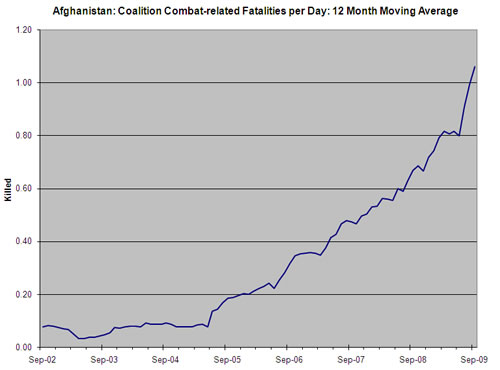
This graph shows the daily rate of coalition combat-related fatalities, on a 12-month moving average basis to exclude seasonal effects. The actual seasonal effect has been increasingly minor, as the recent McChrystal review concluded correctly, "there is no fighting season." What this appears to indicate is an insurgency really appearing in the summer of 2005, and increasing steadily in strength since then. Most recently, in the last 3 months there has been a rapid increase in coalition casualties to an entirely new level. This is largely due to increased-tempo U.S. and British operations in Helmand province, which have taken high casualties. But consistently, every summer has been worse than the last summer, every winter has been worse than the last winter, and we are now approaching 400 coalition combat KIAs per year, and still increasing.
What may be more revealing is when you break those stats out by province and year.
The following charts show combat KIAs per province, starting in 2006. It indicates where the truly heavy fighting is, and where insurgents are making inroads.
 2006. Fighting has just started in Helmand and Kandahar provinces in earnest. Fatalities are observed throughout the west and eastern regions, while the north is immune. Konar, Nuristan, Uruzgan and Kabul provinces (the little comma-shaped one) are the next highest.
2006. Fighting has just started in Helmand and Kandahar provinces in earnest. Fatalities are observed throughout the west and eastern regions, while the north is immune. Konar, Nuristan, Uruzgan and Kabul provinces (the little comma-shaped one) are the next highest.
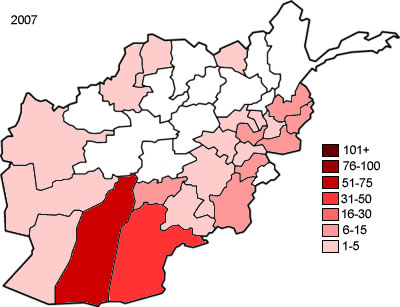 2007. The first coalition KIAs in the north, around Mazar and Kunduz. Helmand gets worse, while Kandahar and Uruzgan stay about the same. The fighting in the east worsens as well in Nangarhar, Paktia and Paktika provinces.
2007. The first coalition KIAs in the north, around Mazar and Kunduz. Helmand gets worse, while Kandahar and Uruzgan stay about the same. The fighting in the east worsens as well in Nangarhar, Paktia and Paktika provinces.
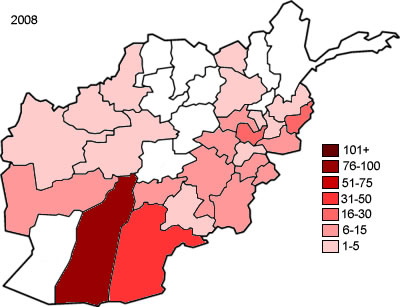 2008. Again, Helmand worsens. Kandahar and Uruzgan and Zabul stay about the same. Coalition casualties increase in all regions over the year before, but particularly in Konar and Kabul provinces. Ghazni and Wardak provinces also see increases in fatalities as attacks on and around Highway 1 between Kandahar and Kabul trend up.
2008. Again, Helmand worsens. Kandahar and Uruzgan and Zabul stay about the same. Coalition casualties increase in all regions over the year before, but particularly in Konar and Kabul provinces. Ghazni and Wardak provinces also see increases in fatalities as attacks on and around Highway 1 between Kandahar and Kabul trend up.
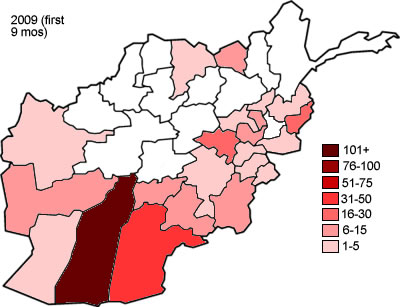 2009 (to today). Partial results for the first three-quarters of this year show where the fighting continues to intensify. (Keep in mind that some of these provinces will get pinker still.) Notably Wardak and Kabul provinces have become significantly more dangerous to Coalition forces this year, as well as Kunduz in the north. Kandahar has also had more combat KIAs this year than last (49 vs 46) so by the end of the year it will likely end up redder than before, as well. But Helmand, which has seen 129 fatalities this year, up from 76 the year before, is still well ahead of all the rest.
2009 (to today). Partial results for the first three-quarters of this year show where the fighting continues to intensify. (Keep in mind that some of these provinces will get pinker still.) Notably Wardak and Kabul provinces have become significantly more dangerous to Coalition forces this year, as well as Kunduz in the north. Kandahar has also had more combat KIAs this year than last (49 vs 46) so by the end of the year it will likely end up redder than before, as well. But Helmand, which has seen 129 fatalities this year, up from 76 the year before, is still well ahead of all the rest.
Helmand's growth in KIAs (as well as Kandahar's and Zabul)'s are obviously somewhat due to increased Western resources being applied there (more targets) in successive years, but as the majority of these fatalities were due to IEDs, and thus insurgent-initiated, the difference in fatality figures between provinces is very much going to be a reflection of where insurgent strategic-level efforts are on the increase as well, rather than purely changes to coalition op tempo.
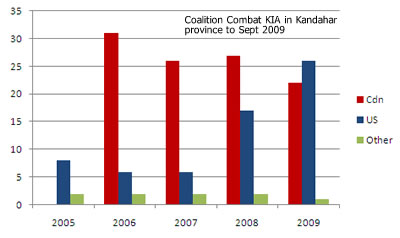 Canadians may wonder at how Kandahar casualties can be on the increase, seeing as we've clearly not seen a significant increase in Canadian death notices in the paper. This final graph may explain that. As of this month, U.S. combat fatalities in Kandahar this year have surpassed Canada's. It is very much no longer our fight to fight alone in that province.
Canadians may wonder at how Kandahar casualties can be on the increase, seeing as we've clearly not seen a significant increase in Canadian death notices in the paper. This final graph may explain that. As of this month, U.S. combat fatalities in Kandahar this year have surpassed Canada's. It is very much no longer our fight to fight alone in that province.
Casualty figures from icasualties.org. Province locations of KIAs checked and corrected where necessary by the author.
UPDATE: Some inferences one might wish to see as supported by the provincial diagrams above, in no particular order:
**Many provinces, particularly in the Hazara-dominated center and the Uzbek-Tajik-dominated north, remain immune to significant Taliban influence. This is no surprise, given they are overwhelmingly a Pashtun insurgency. The exception is Kunduz.
**Uruzgan province, which has been managed by the Dutch and to a lesser extent the Australians, seems to have consistently resisted any increase in Taliban effectiveness, for whatever reason.
**The border areas around Jalalabad, east of Kabul, are seeing marginally less fighting on the whole than in the past. However, there does seem to be a concerted attempt to increase pressure on the environs of Kabul.
(Collected musings on insurgent strategery hived off to another post.)
"endearingly macho" -- Mark Steyn
"wonderfully detailed analysis" -- John Allemang, Globe and Mail
"unusually candid" -- Tom Ricks, Foreignpolicy.com
May 2010
April 2010
March 2010
February 2010
January 2010
December 2009
November 2009
October 2009
September 2009
August 2009
July 2009
News:
The Globe and Mail
The Star
The Wash. Post
Opinion:
TNR
Slate
Washington Monthly
Rants:
Canadians
Penny
Janes
Cosh
The Hound
Coyne
Wells
Farrell, etc.
Steyn
Levant
Afghanistan
The Torch
Abu M.
Bill & Bob
Ghosts of Alex
Registan
Jari
Ink Spots
Ackerman
Kings
FRI
Embedded
Milnews.ca
Can-AFG
The Capt.
Etc.
TMLutas
Sullivan
Marshall
Kaus
Lileks
Reynolds
Welch
Farber
The Shark
Breen
Henley
Electrolite
Samizdata
Slotman
Simberg
Northrup
Bryant
Yglesias
Cole
Drum
Clients/Employers
(Past and Present):
U of T
Cdn. Forces
CG Magazine
LRC
Adrenaline Vault
